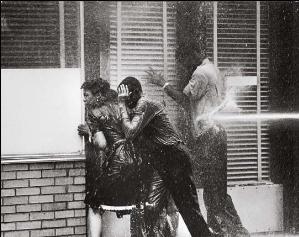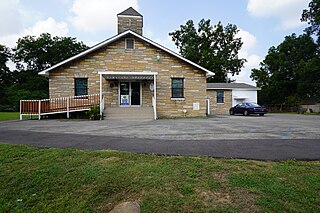
Freddie Lee Shuttlesworth was an American civil rights activist who led the fight against segregation and other forms of racism as a minister in Birmingham, Alabama. He was a co-founder of the Southern Christian Leadership Conference, initiated and was instrumental in the 1963 Birmingham Campaign, and continued to work against racism and for alleviation of the problems of the homeless in Cincinnati, Ohio, where he took up a pastorate in 1961. He returned to Birmingham after his retirement in 2007. He worked with Martin Luther King Jr. during the civil rights movement, though the two men often disagreed on tactics and approaches.

The Martin Luther King Jr. National Historical Park covers about 35 acres (0.14 km2) and includes several sites in Atlanta, Georgia related to the life and work of civil rights leader Martin Luther King Jr. Within the park is his boyhood home, and Ebenezer Baptist Church — the church where King was baptized and both he and his father, Martin Luther King Sr., were pastors — as well as, the grave site of King, Jr., and his wife, civil rights activist Coretta Scott King.

Kelly Ingram Park, formerly West Park, is a 4 acres (1.6 ha) park located in Birmingham, Alabama. It is bounded by 16th and 17th Streets and 5th and 6th Avenues North in the Birmingham Civil Rights District. The park, just outside the doors of the 16th Street Baptist Church, served as a central staging ground for large-scale demonstrations during the American Civil Rights Movement of the 1960s.

Dexter Avenue Baptist Church is a Baptist church in Montgomery, Alabama, United States, affiliated with the Progressive National Baptist Convention. The church was designated as a National Historic Landmark in 1974 because of its importance in the civil rights movement and American history. In 1978 the official name was changed to the Dexter Avenue King Memorial Baptist Church, in memory of Dr. Martin Luther King Jr., who was pastor there and helped organize the Montgomery bus boycott in 1955 during the civil rights era. The church is located steps away from the Alabama State Capitol.

The Sweet Auburn Historic District is a historic African-American neighborhood along and surrounding Auburn Avenue, east of downtown Atlanta, Georgia, United States. The name Sweet Auburn was coined by John Wesley Dobbs, referring to the "richest Negro street in the world," one of the largest concentrations of African-American businesses in the United States.

Birmingham Civil Rights Institute is a large interpretive museum and research center in Birmingham, Alabama that depicts the events and actions of the 1963 Birmingham campaign, its Children's Crusade, and the other Civil Rights Movement in the 1950s and 1960s. The Institute is located in the Civil Rights District, which includes the historic 16th Street Baptist Church, Kelly Ingram Park, Fourth Avenue Business District, and the Alabama Jazz Hall of Fame located in the Carver Theatre. The Institute opened in November 1992, and had more than 25,000 visitors during its first week.

The Birmingham campaign, also known as the Birmingham movement or Birmingham confrontation, was an American movement organized in early 1963 by the Southern Christian Leadership Conference (SCLC) to bring attention to the integration efforts of African Americans in Birmingham, Alabama.

The 16th Street Baptist Church is a Baptist church in Birmingham, Alabama, United States. In 1963, the church was bombed by Ku Klux Klan members. The bombing killed four young girls in the midst of the Civil Rights Movement. The church is still in operation and is a central landmark in the Birmingham Civil Rights District. It was designated as a National Historic Landmark in 2006. Since 2008, it has also been on the UNESCO list of tentative World Heritage Sites.

The Birmingham Civil Rights District is an area of downtown Birmingham, Alabama where several significant events in the Civil Rights Movement of the 1950s and 1960s took place. The district was designated by the City of Birmingham in 1992 and covers a six-block area.

Bombingham is a nickname for Birmingham, Alabama during the Civil Rights Movement due to the 50 dynamite explosions that occurred in the city between 1947 and 1965. The bombings were initially used against African Americans attempting to move into neighborhoods with entirely white residents. Later, the bombings were used against anyone working towards racial desegregation in the city. One neighborhood within Birmingham experienced so many bombings it developed the nickname of Dynamite Hill.

The First Baptist Church on North Ripley Street in Montgomery, Alabama, is a historic landmark. Founded in downtown Montgomery in 1867 as one of the first black churches in the area, it provided an alternative to the second-class treatment and discrimination African-Americans faced at the other First Baptist Church in the city.
Lola Mae Haynes Hendricks was corresponding secretary for Fred Shuttlesworth's Alabama Christian Movement for Human Rights from 1956 to 1963. She assisted Wyatt Walker in planning the early portions of the Southern Christian Leadership Conference's involvement in the 1963 Birmingham campaign during the Civil Rights Movement.
The Alabama Christian Movement for Human Rights (ACMHR) was an American civil rights organization in Birmingham, Alabama, which coordinated boycotts and sponsored federal lawsuits aimed at dismantling segregation in Birmingham and Alabama during the civil rights movement. Fred Shuttlesworth, pastor of Bethel Baptist Church, served as president of the group from its founding in 1956 until 1969. The ACMHR's crowning moment came during the pivotal Birmingham campaign which it coordinated along with the Southern Christian Leadership Conference during the spring of 1963.
Stone Johnson was an African-American activist in the Civil Rights Movement. A railway worker and union representative by trade, he got involved in the civil rights movement in Birmingham, Alabama in the mid 1950s, working with Fred Shuttlesworth. He started a civil rights organization called the Civil Rights Guards that protected homes and business involved in the movement, usually while armed.

Shady Grove Baptist Church is a historic church at 3444 31st Way North, Collegeville in Birmingham, Alabama. The building is of concrete construction that was built in 1942 under the direct of its pastor, the Rev. Lewis J. Rogers. The exterior was faced with Permastone in the early 1960s. It is significant for its congregation's participation in the Alabama Christian Movement for Human Rights rallies for Civil rights in the 1950s and the 1960s under Rogers' direction. The building was added to the National Register of Historic Places in 2005.

Canaan Baptist Church is a Baptist church located in Bessemer, Alabama. It is affiliated with the National Baptist Convention, USA. Built in 1961, it had a congregation active in the Civil Rights Movement of the 20th century and was added to the National Register of Historic Places in 2005.

The Birmingham Civil Rights National Monument is a United States National Monument in Birmingham, Alabama established in 2017 to preserve and commemorate the work of the 1963 Birmingham campaign, its Children's Crusade, and other Civil Rights Movement events and actions. The monument is administered by the National Park Service.

The A.G. Gaston Motel is a historic motel in Birmingham, Alabama. Built in 1954 by local businessman A. G. Gaston, it served as premium accommodation for African American travelers. The Southern Christian Leadership Conference used Room 30 as its headquarters for leaders Martin Luther King Jr., Ralph Abernathy, Fred Shuttlesworth, and others to plan portions of the 1963 Birmingham campaign of the civil rights movement. On May 10, 1963, the motel was bombed by white supremacist terrorists. After discrimination in public accommodation was outlawed, the motel's business declined, and it was used as senior housing from 1982 to 1996. It is now part of the Birmingham Civil Rights National Monument established in 2017, co-owned by the National Park Service and City of Birmingham. It has been designated by the National Trust for Historic Preservation as one of America's National Treasures.



















